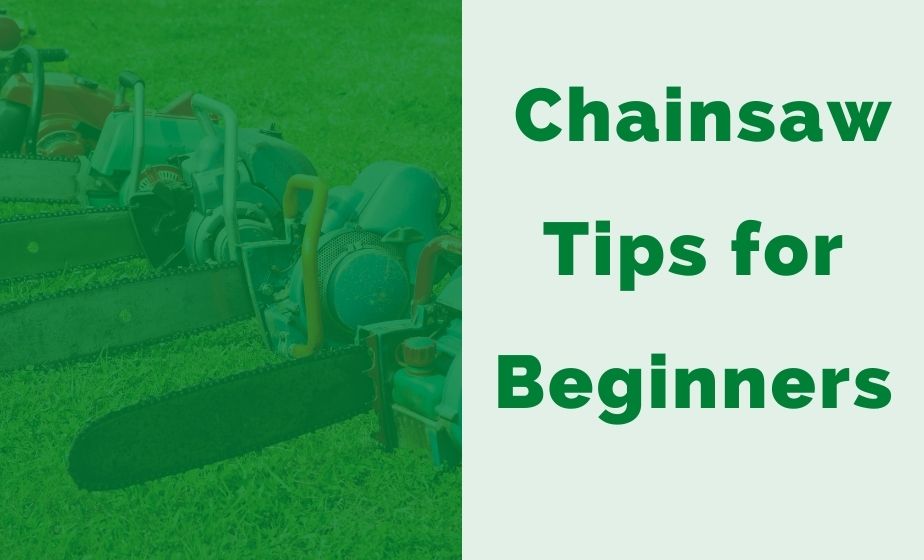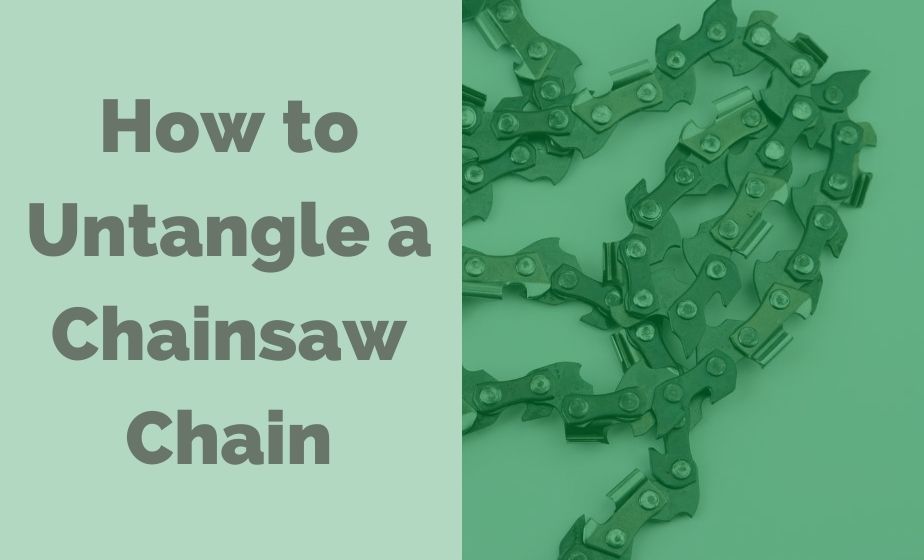Getting started in chainsaw work is an exciting yet daunting prospect. You can learn many terms and techniques. And it is challenging to know who to turn to for advice. We’ve put together a list of the top 10 chainsaw tips for beginners so you can be better prepared when it comes to your first chainsaw job.
This guide offers a few chainsaw tips, specifically for beginners. After all, it’s essential to know the features of the device before ever using it. Of course, as a beginner, you want to have a little knowledge about the tool before you use it. We hope this guide sheds some light on chainsaws and what they can offer as a new user.
How to use a Chainsaw: 8 Best Tricks for beginners
When you are experienced with chainsaws, they are simple tools. You know when to use them and what to do about them. The problem is, many people are not experienced with chainsaws. They struggle to use them while working. It’s essential to know how to use chainsaws.
The best way to use your chainsaw is to know how to do it the right way. But, if you want to make things easier, there are tricks to help you out. This article will tell you some essential chainsaw tricks. These are little shortcuts that can save you time and money if you use them wisely.
Know the Chainsaw’s Limit
A good chainsaw is a must if you own a wooded area and want to do any kind of work, whether it’s trimming trees or cutting up firewood. Chainsaws make the job much easier and faster than using a hand saw, or even a powered hand saw, and there are several brands and styles to choose from. However, before you purchase a chainsaw, you should know the limit.
For large projects, you’ll need a more powerful model with a larger blade. However, when choosing a chainsaw, size is not the only consideration. The length of the bar can also come into play. Longer bars are used for cutting down trees, and shorter bars are suitable for smaller branches.
Now that you know the limits of your chainsaw and the correct bar size for the task at hand, there are some important chainsaw safety tips for beginners.
- The first step is to check the limits of your chainsaw and find the correct size of the bar.
- Make sure your chainsaw chain has the appropriate tension. It should not be too tight or too loose.
- Next, read your owner’s manual and follow the safety guidelines.
- Always wear the proper safety gear, including earplugs, goggles, gloves, boots, and long-sleeved clothing.
- Make sure your chainsaw is sharp and running before you start cutting.
- Replace your chain when it is worn.
- Never saw in reverse, and always be aware of where your saw will fall.
- Keep your work area free of loose branches that could fall.
Oil Reservoir Cap: Is Chainsaw Bar Oil Necessary?
For chainsaw beginners, the oil reservoir cap is one of the essential parts of the chainsaw. It helps to prevent engine damage that insufficient oil levels may cause. Some people prefer to fill their chainsaw fuel tank using a funnel because it’s easier to avoid spilling any gas onto the ground. If you’re not comfortable using a funnel, you can use the chainsaw oil reservoir cap for this purpose instead.
Chainsaw oil is not one size fits all. You will need to choose the correct type for your chainsaws material and features. For example, if you have a metal-cutting chainsaw, you’ll want to use high-hardening chainsaw oil.
This might be a little messy, but you’ll need to keep your chainsaw healthy too. So first, look for the oil cap on the machine and pour some oil into it. You should also check the reservoir cap to see how much oil is left. The oil level is usually monitored via a light inside the reservoir. This light will turn green if it’s low and yellow if it’s getting low. And if the yellow light turns red, you can’t turn on your saw.
Always Have Safety Gear: Why Is Safety Gear Essential?
Working with chainsaws is dangerous. Every year, hundreds of people are injured and killed by chainsaws. The good news is that by wearing the proper safety gear, you can protect yourself from injury. It’s essential always to be prepared and have your chainsaw safety gear on hand, especially if you’re working in a remote area.
- Safety gloves: are crucial for protecting your hands from cuts and bruises. Nitrile, neoprene, or synthetic fibers coat the fingers to provide protection. In addition, most gloves are designed to absorb vibrations. Additional padding is provided for extra impact protection.
- Safety footwear: such as steel toe boots, protects users from heavy objects and machinery. The soles are designed with quality grip so the user can walk on slippery surfaces.
- Safety goggles: are vital to protect the eyes from debris. When operating the chainsaw, or any other power tool with the potential for eye injury, the goggles are necessary to prevent damage. If debris flies into the eye, it can result in splinters striking the eye, which can cause loss of vision and other eyesight complications.
- A helmet: is an important safety device for the head and neck. The dangers of operating a chainsaw are minor compared to the risk of branches falling on you while cutting down trees. Solid and protective helmets that fit well around your head should be worn.
- The best way to protect your hearing is to wear earmuffs or earplugs. If you’re using a chainsaw for an extended period, make sure to protect your ears with equipment like this. And if you’re the one operating the machine, make sure to take care of yourself.
- Chainsaw chaps: are fabrics made of synthetics, which are woven to withstand the power saw. It takes about ten seconds for these chains to get entangled with the material, preventing the chainsaw from cutting. This gives the user enough time to avoid serious injury by immediately removing the chaps and the chainsaw.
Kickback Safety: How To Avoid The Kickback Condition
A kickback is a sudden reaction, usually of the chainsaw’s tip, that can send the tip of the bar, chain, and/or guide teeth flying away from the operator. There is no way to predict when a kickback will occur, but serious injuries are nearly always the result. Because they are not intended to be used as a primary form of safety equipment, kickback guards are ineffective in preventing kickbacks.
This often happens when cutting near the bottom of the bar, which is very typical for beginners. While this may be comfortable, it’s also risky. The device will pull away from you and is hard to control. If you’re new to chainsaws, avoid this at all costs!
Follow these safety guidelines to keep your chainsaw away from harm.
- Hold the chainsaw firmly using both hands.
- Always make sure you test the chain brake before cutting anything and never cut with the tip of the blade.
- Always cut through wood that has been used as building materials or has hidden objects like nails inside. Then, when re-entering the cut, go slowly and be cautious.
Sharpen Your Chainsaw: Is It Worth Sharpening a Chainsaw Chain?
Sharpening your chainsaw is a simple task that you can do at home. If done correctly, it will significantly increase the life of your chain and minimize the risk of kickback. However, in most cases, a chain will start to dull after just a few hours of use. This is because the chain has been pulled from its original shape after being cut through wood.
You are cutting wood with a chainsaw. To make the cuts more precise, you need to use the proper tool. The blade must be sharp. If the blade is dull, then it will be difficult to cut correctly. A sharp chain cuts easily with little effort on the workpiece. A dull or blunt chain tries to move away from the blade.
If your chainsaw is not working properly, it might be due to the excessive use of force. A blunt edge on the blade will cause the pressure of the saw to be distributed instead of being focused. This can lead to your work being less successful. To remedy this problem, you should simply sharpen your chainsaw from time to time. You have to make sure that the chain is always sharp so you can get the best performance out of your machine.
Chainsaws use sharp blades to cut through wood. If you can’t sharpen your chainsaw, you can ask for a new chain for your saw from a nearby tool shop. But don’t work with an unsharpened chainsaw. It will eventually chip and won’t be as effective at cutting. Sharpening your chainsaw regularly will help to avoid this and result in a more precise cut.
Make Your First Cuts: How Do You Start a Chainsaw With a Cut?
Make sure you hold the machine as firmly as possible with both hands. Keep it close to your body and balance yourself. Either has two feet planted firmly on the ground or use one foot as a pivot with the other foot snapped back to give better balance.
These are some essential safety tips for the workplace. First, if you’re cutting light materials, be careful not to let bits fly. Second, when cutting larger pieces of wood, one should be particularly careful. This is because kickbacks can happen, and you might find yourself with a projectile.
Manage The Gasoline After Buying
It’s not worth repairing a small engine after a short period because it can be costly, and if we do not take care of our device, it will need repairs anyway. In addition, a lot of the revenue for tool shops comes from this repair because we need to treat our engine carefully or it will need repairs.
Gasoline, the fuel of chainsaw chains, does not last for long periods. Therefore, when the gas breaks down, it can cause a hard-working engine to stop. To prevent this, a stabilizer should be added to the gas. This should happen shortly after purchase and will save you money in the long run.
Chain Brake: When Should You Use a Chainsaw Brake?
When dealing with a mechanical chainsaw, there are many things that you need to be concerned about. First, the chain brake is something that you need to use on a regular basis. Second, imagine that your chainsaw is one of the more traditional kinds that use gas. Therefore, you will not be able to use it for more than five minutes at most before you have to stop it and let it cool down. This is the main reason why the chain brake is so essential.
Scan Your Work Area Before Start Working
When using a chainsaw, it is vital to make sure your work area is safe. Make sure children aren’t in the area and that there is nothing that could fall onto you while cutting. When starting the chainsaw, use only cold or warm start positions and never drop-start the saw.
Warning And Safety Tips
- Safety is of utmost importance while using a chainsaw. Never use the chainsaw above shoulder height or ground level unless you have experience; someone should always be there with you; don’t drink or take drugs while operating the chainsaw; never use it when you feel tired, and quit while you’re ahead.
- A chainsaw is an excellent tool for woodworking, but it should not be used for other purposes such as digging or levering. Do not use the chainsaw without measuring and examining it about your task. Always wear safety goggles while working. Work in a ventilated space and good weather when possible.
Final Verdict: How to Use a Chainsaw
When using a chainsaw, you should always be careful! A chainsaw is a dangerous tool, and it requires a lot of energy to operate. There are plenty of safety measures in place to prevent injuries, but injuries are still possible. Working with a chainsaw is not a job for the faint of heart. As chainsaws are actually relatively safe when used correctly, it is essential to focus on your work rather than being distracted from happening occurrences. If you feel uncomfortable, stop the process immediately and attend to any problems. For example, with proper attention, you can easily cut down trees with a chainsaw.



